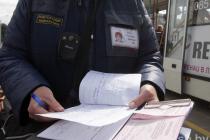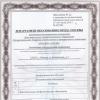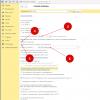A reconciliation report is a document intended to determine the status of mutual settlements between counterparties. The legislation does not oblige organizations and individual entrepreneurs to draw up these documents in mandatory. However, most accounting workers prefer to periodically conduct this work in order to avoid accounting errors and possible disagreements with suppliers and customers.
Purpose of the document
The reconciliation report is intended to document the status of settlements between two organizations on a certain date. Using this document, you can trace all business transactions carried out with the participation of counterparties in the context of contracts or in general for a specific organization, and display the ending balance as of a particular date. This balance can be confirmed by both participants in the reconciliation, or by only one legal entity or IP. If according to accounting data there are discrepancies in the amount of the final balance, then they can be eliminated by studying the transactions that are indicated in the reconciliation report. The accounting records of a particular organization may incorrectly reflect the amount of any sale or payment. If errors are detected, the accountant makes corrections in the accounting, after which a new reconciliation act is drawn up, which is signed by authorized persons.
Frequency of compilation
The legislation of our country does not provide for the obligation of companies to draw up reconciliation reports at a strictly defined time. Each organization independently decides when it is necessary to check mutual settlements with counterparties, and whether it is worth doing it at all. At the same time, there are several situations where this procedure can help avoid accounting errors and conflicts with suppliers and contractors. A reconciliation report is required in the following cases:
1. Before preparing mandatory annual financial statements.
2. When conducting an inventory of mutual settlements with counterparties.
3. If the supplier provides the buyer with an installment plan.
4. Contractors have been cooperating for a long time.
5. Significant transaction amounts or frequent and large deliveries of goods or services.

Reconciliation reports and preparation of annual reports
Most accounting workers prefer to reconcile settlements with counterparties before delivery annual reports. Thanks to this practice, it is possible to find and correct many accounting errors that could affect the reliability of reporting. This is especially necessary for large organizations with a large number of different divisions. In such conditions, documents for the purchase of any product, for example, stationery for a certain department, may simply not reach the accounting department on time.

This often happens when goods are delivered without prepayment at the end of the reporting period. The materials have been received, their shipment is reflected in the accounting of the counterparty, but the accounting department of the receiving organization knows nothing about this. In the case of prepayment, attentive accountants usually try to find out themselves whether there was a delivery and obtain the relevant documents. If the transfers Money has not happened and is not expected in the near future, the delivery of goods will not be reflected in the accounting of the recipient of the cargo. The act of reconciliation with the counterparty allows you to monitor whether all documents on completed business transactions are reflected in the accounting, as well as check the correctness of their reflection. Many employees, when identifying discrepancies between their data and the counterparty’s data, along with a reconciliation report signed with the discrepancies, immediately transfer the missing set of documents. This significantly speeds up the process of correcting accounting errors.

Document form
Each enterprise can develop and approve its own form of reconciliation report, which will suit all interested parties and will allow the inspection to be carried out correctly. Regulatory acts There is no unified form for this document. But, since it is primary, when drawing it up, all the requirements imposed by law for the preparation of this type of documentation must be taken into account. In particular, the reconciliation report must have the following details:
1. Name.
2. Date of its formation.
3. Information about the compiler.
4. Brief summary of the operation performed.
5. Meters of the specified business transactions.
6. Indication of the positions of persons responsible for recording business transactions and documenting them.
7. Handwritten signatures of the indicated officials.

Filling procedure
The main part of the reconciliation report, which contains information about business transactions carried out by counterparties, is a table. It consists of two parts. On the left, as a rule, the activities of the organization that compiled the document are reflected. It includes four columns. The first of them indicates the serial number of the entry, the second - a brief summary business transaction, in the third and fourth - her monetary value by debit or credit. The right side of the table remains blank; The data is recorded there by the counterparty when he performs reconciliation. Thus, the act in question contains - in chronological order - records of all operations carried out by the organization, with the participation of a specific counterparty, for a certain period. After that, debit and credit turnovers are calculated, and the ending balance is determined for the required date.
Carrying out reconciliation
The company that has received the reconciliation report from the counterparty compares the data of its accounting with information provided by the originating organization in the document. The date of the business transaction, its type and amount are checked. The accounting employee also reconciles the balance at the beginning of the period. If inconsistencies are detected, it is best to first check that the documents are reflected correctly in your own accounting. To do this, you will need to raise invoices and invoices submitted by the counterparty or issued to him. If an error is detected, the accounting data is subject to adjustment, after which the reconciliation is carried out again. If no error is detected, the employee indicates his information on the right side of the report, calculates the turnover and the final balance. The reconciliation report is sent to the counterparty with discrepancies.

Signing Rules
The document must be signed by the director and chief accountant of the company. The organization's seal is placed in the space provided for this purpose. It should catch the last couple of letters of the signatures. In the absence of the manager or chief accountant, the reconciliation act is certified by the signatures of other officials of the organization who have the right to sign such documents. At the same time, their position is indicated.

Document status
The reconciliation act allows you not only to identify errors in accounting, but also to avoid disagreements with counterparties. If, for example, a debtor of an organization signs a document, then he agrees with the state of settlements and thereby expresses his readiness to pay the debt. The act of reconciliation with certain other supporting documents also serves as the basis for writing off bad debts after the expiration of their limitation period. A document signed by both parties is also required when the company goes to court to collect debt from the counterparty for goods supplied or services provided.
According to the Regulations on accounting and financial reporting in the Russian Federation, the preparation of annual accounting (financial) statements in the Russian Federation must necessarily be preceded by an inventory of all assets and liabilities.
Note that accounts receivable relates to the property of the organization, and accounts payable- to financial obligations.
An inventory of settlements with suppliers, buyers, various debtors and creditors consists of checking the validity of the amounts of receivables and payables listed on the balance sheet.
At the same time, reconciliation of settlements between counterparties makes it possible to reliably assess the correctness of the reflection of debt amounts.
Why do you need an act of reconciliation of settlements with counterparties?
A timely and correctly executed act of reconciliation of settlements with counterparties allows you to eliminate errors in accounting and tax accounting.If the debt reflected in the reconciliation report coincides according to the organization’s data and the counterparty’s data, this means that all business transactions with the specified counterparty are reflected in the accounting records correctly and in a timely manner, including operations for the shipment of goods, provision of services, performance of work, receipt and transfer of funds. funds are not missed or doubled.
Thus, the reconciliation act allows not only to identify errors in accounting, but also to avoid disagreements with counterparties.
In addition, if a debtor of an organization signs a document, then he agrees with the state of settlements and expresses his readiness to repay his debt.
The act of reconciliation of settlements with counterparties also serves as the basis for writing off bad debts after their expiration date. limitation period.
The act of reconciliation of settlements with counterparties can be used when going to court in order to collect debt from the counterparty for goods supplied or services provided.
For what period is it necessary to reconcile settlements with counterparties?
Before reconciliation, you should establish a period for which data should be included in the document being compiled.When taking inventory of settlements with buyers and customers, with suppliers and contractors, as well as with other debtors and creditors, the organization should reconcile mutual settlements with its counterparties as of December 31 of the reporting year, which are documented in acts of reconciliation of mutual settlements.
The procedure for reconciling settlements with counterparties
The act of reconciliation of settlements between counterparties is drawn up on the basis of data from the two parties who take part in the reconciliation.The organization that initiates the reconciliation informs the other company about the need to conduct a reconciliation and draw up a report.
After this, the first organization identifies the amount of debt from its data and informs the second organization about it.
If the second organization agrees with the amount of the debt, then the first organization draws up an act, prints it out in two copies, signs it with its manager and submits it to the second company for signature.
If the second organization has objections regarding the amount of debt, then it is necessary to proceed as follows:
- The accountant of the first organization fills out only his part of the act and sends the document by e-mail or fax to the accountant of the second organization.
- The accountant of the second company enters his data, and thus discrepancies are identified.
- The party that has erroneous accounting data is identified makes the necessary changes in accounting.
- After this, the first organization generates a new, already adjusted, statement of reconciliation of calculations, including data from both parties to the agreement. The act is drawn up in two copies and no longer contains any discrepancies.
- The reconciliation report is signed by the heads of both organizations and stamped.
Form of reconciliation act
The reconciliation report reflects business transactions carried out between two counterparties for a certain period and displays the amount of debt.The legislation does not provide unified form of this document.
Therefore, the organization develops the form of the mutual settlements reconciliation act independently.
In this case, the form should be approved as an annex to the accounting policy.
Note that the reconciliation act is not the primary accounting document confirming the completion of a business transaction, since it does not affect financial condition sides
Therefore, reflect in the act all the details established for primary documents in paragraph 2 of Art. 9 Federal Law dated 06.12.2011 N 402-FZ “On Accounting”, optional.
- name of the document - act of reconciliation of calculations (indicating the names of organizations);
- details of the agreement concluded between the parties;
- date and place of document preparation;
- Document Number;
- the period for which the reconciliation was carried out;
- the amount of debt of one of the counterparties (indicate which one) at the beginning of the period for which the reconciliation is being carried out;
- the amount of business transactions carried out between counterparties (each party enters its data);
- dates of business transactions between counterparties (each party enters its accounting data);
- details of documents confirming the completion of business transactions between counterparties (each party enters its own credentials) Such documents are invoices, acts of acceptance and transfer of results of work performed/services rendered, payment orders, cash orders etc.;
- the amount of debt of one of the counterparties (indicate which one) at the end of the period under review;
- there are discrepancies in the parties’ credentials;
- signatures and seals of the parties.
The left side of the table usually displays facts economic activity organization that compiled the document.
It includes four columns.
The first column indicates the serial number of the entry, the second column - a summary of the business transaction, the third and fourth columns - its monetary value by debit or credit.
The right side of the table remains blank; The data is recorded there by the counterparty when he performs reconciliation.
Thus, records are entered into the act in chronological order about all operations carried out by the organization with the participation of a specific counterparty for a certain period.
After that, debit and credit turnovers are calculated and the total amount of debt (closing balance) as of a certain date is determined.
If there are no problems or errors, then the amounts received after filling out the first and second tabs will look mirrored in the table.
For the reconciliation act to become legal, it must be signed by authorized persons on both sides.
The reconciliation report can be signed by authorized persons by the sole executive body of the organization (for example, general director, financial director, etc.) or a representative acting on the basis of a power of attorney issued by such a body.
An act of reconciliation of mutual settlements is a document that reflects the state of settlements between two parties (companies, counterparties) for a certain period of time. In our article we will teach you how to fill it out correctly and give an example for downloading.
Samples of filling out the reconciliation report forms and an approximate form of the form are presented below:
Why do you need a reconciliation report?

- If you plan to renew large contracts;
- If you need to organize mutual settlements;
- During the inventory period;
- When one of the parties trades in installments;
- To prepare reports on debts for management, regulatory authorities, etc.;
- if mutual settlements involve goods of very high value;
- To clarify settlements between the parties.
The legislation does not oblige organizations to draw up acts of reconciliation of mutual settlements at any specific time; this is decided by the organization itself.
The reconciliation report consists of two parts - for two enterprises. The left column is filled in by the initiator of the act, the right column is filled in by his counterparty. Typically, a reconciliation act looks like a list of documents ordered by creation date. Or, instead of documents, the transactions performed are listed: sale, purchase, payment, etc.
Form of reconciliation act
- act number;
- the period for which the reconciliation is carried out;
- names of the parties (organization and person acting on its behalf);
- details of the agreement between the parties;
- Information about transactions (with numbers and dates of invoices, payment orders or other papers confirming the delivery and payment of services or goods), transaction amounts;
- Closing balance in monetary terms;
- Handwritten signatures of the accountant and director, stamp;
- Dates of signing the Act.
The document is drawn up in two copies and signed by the chief accountant and director of the organization. If there are no property disputes between organizations, and the drawing up of the act is purely nominal, only chief accountants can sign it. But such an act will not be valid in court.
Then, to check your own register of transactions and enter the results in the right column, both copies are sent to the counterparty’s accounting department. If the counterparty agrees with the data specified in the act, then a second seal and signatures are affixed. One act is returned to the initiator, the second remains with the counterparty.
Do you want to speed up the issuance of documents and eliminate possible errors when filling out? The Business.Ru store automation program will help you. It will allow you to automate tax and financial statements, and also control cash flows in company.
If any discrepancies are found, a note about this is made at the bottom of the document. If, due to detected discrepancies, the counterparty refuses to sign the act, and the initiator’s claims are confirmed by other documents, the initiator can sue. To speed up the resolution of such disputes, the contract must stipulate in advance the terms within which the counterparty is obliged to make its own calculations and return the signed deed or pay off debts.
Pseudo chicks, glowing with their sexuality, are very demanding of their appearance: makeup, hairstyle, manicure. Young trannies in stockings in the photo look like true courtesans and can also professionally caress the phallus of a sexual partner.
What are we checking? Why are we checking?
It is customary for businessmen to back up transactions with written agreements. We bought the goods and signed the invoice. We provided a service and signed an act of provision of services. And we usually make two sets of documents. One, with the signatures of the counterparty (supplier or buyer), remains with you, the second is taken by the counterparty himself. Then you give all the documents to the accounting department, or write them down yourself accounting program or a database where you keep records of your transactions. And you are waiting for payment from the buyer. Or pay the supplier. You also record the date and amount of payment in your transaction database.
All. The deal is closed. And you have accumulated, say, 100 such transactions in a year. And in January of next year one of your suppliers calls and asks in a stern voice why you still haven’t paid him?
Ummm... How is this? Let's figure it out. Let's open our database. And we see: lo and behold, the transaction is closed, the goods are received, payment is made. That's payment order you can take it out of the folder and send a scan to the supplier so that he can see for himself that you have paid.
An hour after receiving the payment scan, your supplier calls back again and asks for forgiveness for his mistake. It turns out that his accounting department mistakenly recorded your payment not to your account, but to a transaction with another counterparty with a similar name.
And you complacently forgive him (and you secretly wipe the sweat from your forehead, phew, it’s still not your mistake, you don’t have to worry about penalties).
What if ten more contractors call and demand payment?
Common situation?
If not, we bet you are a very attentive person and know the value of money.
If yes, then you probably don’t want to get into such trouble again.
What needs to be done to avoid such incidents with counterparties?
It’s simple: you need to regularly (or at least once a year) reconcile your data and certify mutual settlements on paper. And this paper is called the Reconciliation Act.
Act of reconciliation
When you and I look at this accounting phrase, it seems to us that only a specially trained person can understand and do it. It's really just two words.
An act is a piece of paper with numbers and signatures. Reconciliation is a comparison, comparison of information in order to find out that everything is correct.
How to draw up a reconciliation report? 7 simple steps.
- Make a list of your counterparties. Let these be two lists. In one you will list the suppliers. In the other - buyers.
- For each supplier, make a list of purchases and your payments. For each buyer - a list of sales and his payments. Make a list for each of the counterparties in the form of a plate.
- At the top of the sign write the names and representatives of your and the counterparty’s companies (as is usually done in the header of the agreement).
- Just below write the date and place of drawing up the reconciliation report (for example, 10.22.13 Moscow), the period for which the report was drawn up (for example, 2013) and the name of the document - Reconciliation Report.
- Place your signature under the table and leave space for the signature of the counterparty.
- Submit two identical Reconciliation Reports to your counterparty, accompanying it, for example, with the following letter:
Dear Counterparty!
We are sending you a reconciliation report as of 10/22/13. We ask you to sign and return to us one copy of the act within 10 days, or disagreements regarding the reconciliation act with supporting documents (acts, invoices, invoices). In case of failure to receive the signed act within the specified period, or disagreements regarding it, we will consider the settlement balance confirmed.
7. Wait for the counterparty to return the signed reconciliation report to you and put it in a separate folder where it will always be easy to find if you need to refresh your memory.
You see, there is nothing wrong with the reconciliation itself. And if you are missing some documents, you can request them again from the counterparty.
And a little more about preparation
P.S. Shaving is not difficult. But if you are in a hurry to leave the house, and you need to drink coffee, shave, find socks, tie a tie, and remember the car keys at the same time, then simple actions turn into incredible tricks.
And if you wake up half an hour earlier, take out a razor and a towel, put your car keys in the right place, and prepare your tie the night before, you can easily avoid the morning rush.
Likewise, you can take care of reconciling settlements with counterparties in advance. To go to work on January 10th and sit down to carry out the prescribed algorithm.
Information for you:
We will prepare for you a reconciliation report with any counterparty of any complexity and volume
Contact us by phone: +7 925 720 82 11 or .
Mutual accounting, control and strict regulation of financial and economic activities are essential to cleanliness, timeliness and the absence of disagreements in settlements with counterparties. For these purposes, in modern document flow, an act of reconciliation of mutual settlements is used.
What is an act of reconciliation of mutual settlements?
The act of reconciliation of mutual settlements (mutual settlements) is accounting document, which is compiled to reconcile mutual settlements between the parties (organizations, individual entrepreneurs etc.) for a certain period of time (month, quarter, year). The data indicated in the act by the initiating organization must match the information of the counterparty. If discrepancies are found in the data, this is recorded in the final part of the document.
Currently, the legislation does not establish an official form for such a document. Also, the obligation to draw up a reconciliation act for mutual settlements is not established by law; however, this is one of the most common and sought-after documents in business transactions, necessary to comply with all terms of contracts. If necessary, each organization can develop its own reconciliation report form. However, it should be drawn up taking into account the requirements for primary accounting documentation.
The act of reconciliation of mutual settlements must indicate the number, reconciliation period, and name of the organizations. The act must contain a table in which the debit and credit data are entered on the numbers and dates of the primary documents confirming the delivery and payment of goods. The end of the form should contain the turnover for the period and the ending balance.
The act of reconciliation of mutual settlements is necessary:
- when the seller of the product provides a deferred payment
- when providing standard, regular services
- at high cost of goods and services
- when concluding a large number of contracts and additional agreements to them
The form of the act of reconciliation of mutual settlements is drawn up by the accounting department of the organization and signed by the general director and certified by the seal of the organization. The act is drawn up in two copies, which are subsequently sent to the counterparty. When sending the act, it is important to indicate the period during which the counterparty must sign the act and return one copy to the initiating organization. If representatives from organizations are sent to sign the reconciliation report, they must have powers of attorney with them.
Only chief accountants of companies can sign an act of reconciliation of mutual settlements, but this is only possible if no discrepancies are found in the act and the organizations do not have disagreements. It is worth understanding that in the event of a disagreement, an act submitted to the court without the director’s signature will not be valid.
When drawing up acts of reconciliation of mutual settlements, it is necessary to check several accounts:
- income calculations
- settlements on advances issued
- calculations for shortages
- settlements of accepted obligations
The act of reconciliation between organizations that do not have property disputes is purely a technical detail. Reconciliation can be carried out both for a specific contract and for the totality of commercial relations with the counterparty organization for a certain period.
The form of the act of reconciliation of mutual settlements can be downloaded from this link: Form of the act of reconciliation of mutual settlements (*.xls, 28Kb).
An example of a correctly completed settlement reconciliation act is shown in the picture below (clickable):

“Payment (000506 dated September 25, 2013)” - receipt/debit of funds from the account
“Sale (19 of October 31, 2013)” - confirmation of the provision of services (service provision certificate), transfer of goods (invoice)
You can download an example of a correctly completed settlement reconciliation statement using this link:














